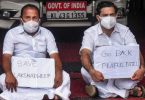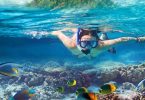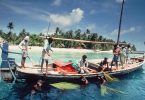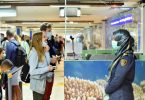The first thing I notice about the airport in Male is that the warning signs prohibiting dogs, alcohol and idols are gone, as are the dour customs officials with their x-ray machine. Instead, the arrivals hall is air-conditioned and friendly, with no enforcers in sight.
In fact, a second floor with a business lounge and shops has been added, and an enormous new international terminal is under construction.
We have just come from Tel Aviv via Dubai on Emirates Airlines. What used to be an arduous trek from Israel is now two short hops of three hours each. On the plane, flight attendants hand out red sealed boxes of the new travel necessities: anti-bacterial wipes, Alco-gel and a mask. The Maldives, after closing its borders for five months, has reopened and the tourists are coming back.
I am a terrible traveller. I always over-pack, worried that I’ll bring the wrong shoes or bathing suit. My suitcase is overweight and impossible to close. I get to the airport early and then fret, checking my passport and tickets, imaging every possible thing that could go wrong.
Now there’s a whole new gauntlet of tests, health forms and government documents for me to obsess over. Social distancing doesn’t work very well on escalators, airport shuttles or on planes, for that matter. Oh, and did I mention there’s a cyclone hitting Sri Lanka, the edges of the storm heading to the Maldives? At this point, I want to turn to my husband and say, “I could be at home watching Netflix. Why are we doing this? “
Soon the answer is right outside my window. We are en route to the Thaa Atoll, 170 kilometres from Male. By some combination of luck and timing, we are the only ones aboard a 15-passenger seaplane. With the storm kicking up behind us, we fly through billowing cloud formations, but the real attraction is down below: a succession of aquamarine lagoons, circled with coral reefs, glittering like open geodes tossed into the ocean’s lap.
The Republic of the Maldives is a 754-km. (469-mile) a string of 26 atolls, groupings of small islands leftover from an ancient volcanic chain. There are over 1,000 tiny islands, none of them more than two kilometres across. But only 200 are inhabited, with more than half of those occupied by resorts. The capital island is Male, which takes the brunt of the population: 150,000 people packed into 1.6 kilometres, making it the smallest capital in the world and congested beyond belief.
The rest of the Maldives, however, seems to have been designed for pandemic travel, since there is only one hotel per island. We are headed to the COMO Maalifushi, the only resort in this remote southern atoll. Founded and run by Singapore entrepreneur Christina Ong and her daughter Melissa Ong, (hence the acronym) COMO is a collection of luxury hotels and retreats that specialize in privacy, tranquillity, health and what they loosely refer to as “guest well-being.”
It’s not too difficult for one’s being to feel well here, with an array of 65 suites and villas, each with a private pool and sitting area. They range from cosy hideaways on the beach, to the most popular lodgings: over-water villas suspended on top of the lagoon, with steps down into the coral-filled waters and private decks facing an endless stretch of blue.
THE DÉCOR is deceptive, with thatched roofs and bleached wood designed to blend in with the sand and water. But inside are Egyptian cotton sheets, personal yoga mats, bottles of sparkling and still water, fresh ice every day, and a butler assigned to each guest to personally deliver your heart’s desire. Add to that mix a world-cuisine dining room, spa with eight treatment rooms, sauna, gym, yoga pavilion, Japanese restaurant, two bars… am I missing anything? Oh yes, a children’s club, dive centre, boutique, water sports centre, and if you’re feeling crowded, a small, completely uninhabited island a short kayak paddle away.
But at this moment, looking out the window of the seaplane, it seems impossible that there is anything out here, let alone a luxury retreat. In all directions, it is the only ocean, beautiful and untamed, vast and frankly terrifying. When we land, it is next to a small group of islands in one corner of the atoll. The plane putters through the reef and stops next to a floating wooden deck with enough room for a small bench, a few pieces of luggage, my husband and me.
The sea is rough from the storms and the deck is bobbing wildly. Mask still on, dressed in my winter travelling clothes, I see the resort crew coming to pick us up, and I have never been so happy to see a boat in my life. We are greeted with cool towels infused with the COMO signature scent of eucalyptus, peppermint and lavender, and introduced to Joy, our personal assistant for this stay, and I want to cry with relief.
Adding to the Robinson Crusoe effect, we seem to be the only guests on the island. The COMO Maalifushi officially reopened this November. Their first guests were an unexpected German production crew who took over the entire resort to film for three weeks. But when we arrive, there is only one other villa occupied – by a British couple with their two-year-old, who came for two weeks, which turned into three, then four. They seem extremely relaxed and disinclined to ever leave.
The resort is still catching up on repairs, gradually bringing back staff, and gearing up for the holiday reservations, when for the first time since the pandemic hit, they will be fully booked. But the times they are a-changing’. I am sitting with the director of sales and marketing, Khumar Askerova. We have parked ourselves outside, in a breeze that ruffles my hair and clothes. Khumar, originally from Azerbaijan, has worked in the Maldives for five years, and in the hotel business for much longer than that. She, like all of the staff, is required to wear a mask. The guests are free to choose, but after the first 24 hours on the island, no one does. I feel completely relaxed, safe and tempted to pretend COVID-19 never existed. But she explains how the resort has adapted.
The Maldives requires a negative PCR test to enter, and most resort activities take place outside, so that part was easy. But now restaurant tables have been spread further apart and buffets discontinued. Trips to the neighbouring inhabited islands have been suspended and the number of guests allowed in the gym, yoga classes and excursions is limited. Rooms are disinfected and left empty for 24 hours between guests. Alco-gel dispensers abound, and 10% of the rooms are designated for staff to occupy during a mandatory quarantine on their return when they are tested, isolated and then not allowed to leave. Even the workers with families on the neighbouring island of Guraidhoo, which we can practically wave at, stay put. Soon the resort will have its own PCR testing machine on-site, with results in 40 minutes.
IN SHORT, they have created an island refuge of sandy paths, palm trees and scented flowers, where, for the length of my stay, I can indulge in the new luxuries: breathing without a mask, being served coffee at a table, talking with random strangers, and examining the world around me without fear.
Added to this are the more subtle luxuries: privacy, tranquillity, and harmony with nature. On Maalifushi, the ocean is our friendly companion. Underneath the Japanese restaurant, reef sharks gather like floating puppy dogs, waiting to be fed treats. An octopus settles in the coral nearby, stretching its limbs from translucent to rock-hued camouflage, just for me. The beach and paths are meticulously groomed every morning. The first day I carry my sandals around with me. The second day I forget them at breakfast. By the third, I don’t even bother.
I know it’s an illusion, but I love it. And yet, one morning, walking down the beach to breakfast, I come across plastic bottles, half a Styrofoam container, and a small light fixture. And then there’s the life jacket hanging in my closet, with “Use In Case Of Emergency” written in seven languages. I spend a few moments contemplating what kind of emergency would require a life vest while standing on dry ground, and decide I don’t want to go there.
Four days into our stay, I want to see how the island really runs. Joy volunteers to be my guide. He is from South India and has been with the resort since before it opened in 2014.
“We work as a family,” he explains, and then warns me. “If you stay here too long, you will fall in love. You will never want to leave.”
It turns out that one of the costs of solitude is the need to ship in everything. The fruit is imported from Thailand, milk from Australia, alcohol from Dubai. But fish, of course, is local, along with any produce island residents can convince to grow. Coconut tree leaves and shells are composted into fertilizer for the kitchen gardens where four kinds of basil and various chillies thrive, salad fixings sprout, and fresh aloe plants are available to treat anyone’s sunburn.
It’s hard to believe you can hide anything on an island this size, but we continue past the gardens into the inner workings of the resort, where the illusion of being mysteriously pampered cracks a bit. I am greeted with friendly but shocked stares. Here, the 200 staff are fed and quartered, with their own beach and bar. Here, waste is recycled, coconuts turn into garden soil, and solar panels and generators feed into a universal power platform. I see how pumps bring up groundwater from the island’s aquifers to be desalinated, filtered and bottled, ending up as sparkling water in my mini-bar back at the villa.
The Maldives banned single-use plastic items four years ago, but even before then, the resort had none of it. Shampoos and soaps appear in ceramic containers, drinks in glass bottles, even the complimentary toothbrushes are made from bamboo and natural fibres.
In a session run by Lisa, the resort’s marine biologist, we are reminded how serious the problem is. Unsuspecting turtles eat plastic bags that look like jellyfish. Ghost nets discarded from fishing boats strangle whales, sharks and dolphins. While most islands burn their garbage, some just wait for the waves to wash it away. And let’s not forget micro-plastics. Polyethene from face scrubs, cosmetics and synthetic fibres are digested through the ocean’s food chain until they end up on our plates. In 2010 it became illegal to fish sharks, turtles or parrotfish. But poaching continues; green turtles for their meat, Hawksbill turtles for their decorative shells.
BUT THE biggest endangered species are the coral. One-quarter of the ocean’s life is sheltered by coral reefs, which cover less than 1% of the Earth’s surface and have their own fragile ecosystem. If the ocean gets too warm, it kills the reef’s algae, leaving the coral to starve. In 2016 this occurred on a massive global scale, bleaching almost 75% of the world’s coral, turning reefs that once looked like underwater gardens turned into mass graveyards.
Lisa is continuing a resort project of re-growing coral. Guests can sponsor a small, medium or large frame, where pieces of healthy coral are attached, lowered into the lagoon, and left to reproduce and multiply. You can even get updates on your frame via WhatsApp. Within a year, the frame is covered and the coral is well on its way.
Fortunately, the Maldives seems to have escaped the worst of this damage. The house reef surrounding the resort is still filled with turtles, reef sharks and moray eels. Christmas worms duck back into soft coral. Clownfish hide in sea anemones. A peacock flounder flattens itself against a rock.
Ninety-nine per cent of the Maldives is the ocean. And tourism is its meal ticket. In 1972 there were three resorts. Today there are more than 132 and counting, with almost 12 new properties opening a year. To keep up with the demand, the government has authorized “land reclamation” where new “islands” are created by dredging sand onto existing, healthy reefs and building on top of them.
“I wouldn’t go near those resorts,” admonishes Lisa. “It’s a matter of principle.”
And so, the mighty ocean, which could rear its head in a tsunami or cyclone, has met its match. Responsible tourism can protect it. Run amok, it’s just another predator.
It’s almost sunset. Again, we are the only guests on a boat, waiting in a channel where the atoll opens into the swells of the Indian Ocean. This is when schools of spinner dolphins cross over for their night feeding. I was afraid that the stormy weather would scare them off, but instead, the waves make them more playful. We see a small pod next to the boat, and then a few gliding out of the water, and then there are simply hundreds of them, leaping, spinning, jumping, clicking and whistling to each other. I want to think they are showing off for me, but no, they do this every day. After all, they live here.
On the morning of our departure, we get up at the unusual hour of 6:00 a.m. The island is exactly like we found it, quiet, deceptively empty. And just as Joy had predicted, I don’t want to leave.
As our luggage is taken to the boat dock, I have a strange sense of going forward in reverse: the same scented towel, this time as a farewell, the same boat to the floating wooden deck, mask back on, shoes back on, three metal steps back into the seaplane.
All too soon we will be flying over the busy shipping traffic of Male. Soon, our temperatures will be taken, our forms presented, our test results checked. Soon, we will glare at passengers not wearing their masks. We will grab onto seat backs and door handles, and wonder what other germs have touched them. In the airport, there will be signs with the motto, “Stay calm. Stay safe.”
But for now, we still have a few minutes left with the morning breeze, the soothing hush of ocean, a stingray gliding next to us in the sandy lagoon, drifting back and forth in the turquoise water, until we reach the end of the pier.
Full details are available at the link below:
Source URL: Bing News :






